Korean Film History
The Advent of Cinema and
the Early Korean Cinema 1897~1953
| 1. The Exhibition of Moving Pictures and the Advent of Korean Cinema
| 2. The Japanese Colonial Period, Heyday of Silent Films
| 3. The Sound Film and Militarism
Korean Film History
Building Up the Industry and
the Renaissance 1954~1962
| 1. Liberation and the Korean War: 1945~1953
| 2. The Revival of the Film Industry: 1954~1962
Korean Film History
The Korean Cinema Renaissance
and Genre Films: 1963~1971
| 1. The Korean Cinema Renaissance: 1963~1971
| 2. Legacy of Realism in Korean Cinema: 1950~1990s
- The Border(국경, 1923, by Won San-man): First Korean complete feature film
- The Vow Made Below the Moon(월하의 맹세, 1923, by Yoon Back-nam)
- Story of Chun-hyang, Story of Jang-hwa and Hong-ryeon
- Park Seung-pil(Dansungsa Theater): first in-house film production
- Chosun Kinema(1924, Busan), Yoon Baek-nam Production(1925), Na Woon-kyu
Gisaeng: the first star actresses – Lee Wol-hwa
- Lee Wol-hwa: Started from stage plays, stardom from Fight For Justice
- Han Ryong(Han Myung-ok): Story of Chun-hyang, famous gisaeng from Gaesong
- Gisaeng as the first actresses: before, male actors performing female roles
- Fight for Justice(Eurijeok Gutu, 의리적 구투, 1919): stage play + shinpa melodrama
- Active participants in Korean film production for a decade: Chosun Gisaeng Guild
Heyday yet Invisible in Korean Film History
- 1920-mid 1930: Heyday of Korean silent films: Lack of materials from this period
- 140~50 films were produced during the period: about 80 released b/w 1926~37
Crossroad of the Youth (Cheongchun-eui Sipjaro,청춘의 십자로)
1934, dir, Ahn Jong-hwa
Recently restored Korean silent film
Nationalism and Colonialism
- Nationalism: Na Woon-hyu, Arirang(아리랑,1926) – 1st Korean masterpiece
- Triggered productions by young generation: Under heavy censorship by Japan
- Nationalistic film form: character, theme, narrative, style
- Maverick brought heyday in Korean cinema: ended with Na’s death in 1937
- Filmmakers, Actors flew to Shanghai: Jin Yan(김염), Heo Young(Dr.Hu Yung)
Controversial Issues in Korean Silent Films
- Public awareness of drastic social changes
- Shinpa melodrama: female characters abandoning Confucian ideology and values
crucial impact and long-time influence on Korean films and Television
- Male elites: attraction yet mixed with contempt and fear against national/social situations
- Socialism as ideological basis for the independence movement: impacts on films
- Only 5 socialist films were made: Due to Japanese imperialism and capitalism
- Development of film techniques: cinematography. editing, recording, developing
- Motion Picture and Film Censorship Regulation(1926), Japan attack China in 1930
Limitation of film production in the period
Byunsa: A True Star of Korean Silent Films
- Originated from old forms: kabuki, bunraku, pansori
- Byunsa as Narrator, interpreter, audience leader (from domestic films to foreign)

- 오늘 본 자료가 없습니다.
- 사회보장급여 이용·수급자 발굴에 관한 법률 입법 배경과 목적을 기술하고 복지사각지대 개선을 위한 방안을 제시하시오 답안 작성 시 이 법의 법률적 정의와 입법배경, 필요성과 목적, 복지사각지대 해소를 위한 정책현황과 법률적 개선에 따른 실천방안의 3개 파트로 구분하여 작성하시오
- [A+]아동 중심 놀이치료 상담 사례.놀이치료 치료적 제한설정 하기.아동 중심 놀이치료 축어록.아동 중심 놀이치료자의 역할과 반응 연습 보고서.구매 평가:A+
- 학교사회복지가 도입된 사회적 배경을 서술하고, 우리나라에서 어떻게 발달했는지 과정을 정리하여 설명하고 현재 우리나라 학교사회복지의 문제점이 무엇이 있는지 본인의 생각과 제언을 구체적으로 제시하세요
- 학교중단, 학교폭력 문제에 대해 적극적이고 효과적으로 대응하기 위한 여성가족부와 교육부의 연계방안으로 무엇이 있는지 논하시오
- [청소년문제] 청소년 관련 문제 중 가장 심각하다고 생각되는 주제를 정하여 개념, 문제점, 현황과 실태, 개입방안 등에 대해
해당 정보 및 게시물의 저작권과 기타 법적 책임은 자료 등록자에게 있습니다. 위 정보 및 게시물 내용의 불법적 이용,무단 전재·배포는 금지되어 있습니다. 저작권침해, 명예훼손 등 분쟁요소 발견 시 고객센터에 신고해 주시기 바랍니다.



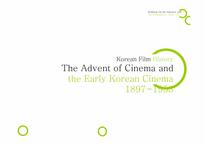
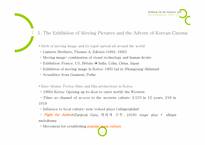
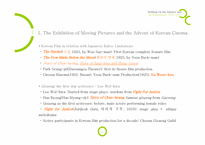
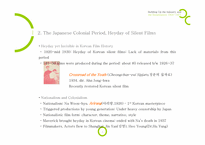
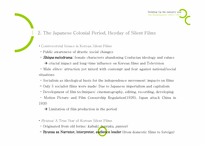
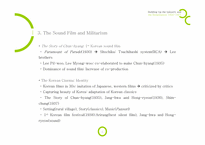

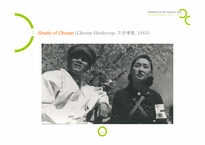
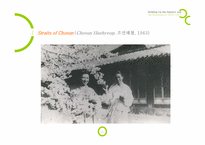
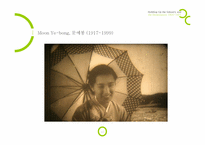

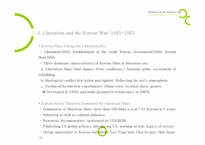
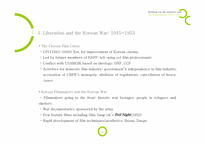
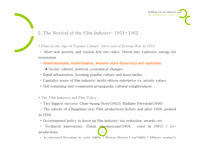
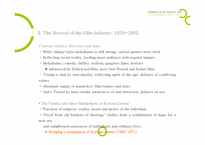
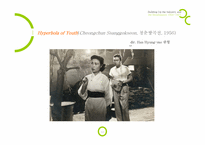

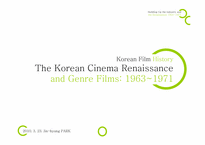
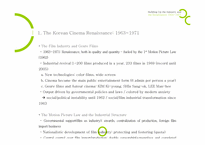
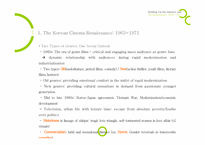
 분야
분야

